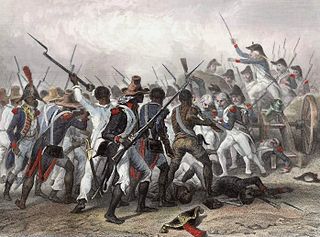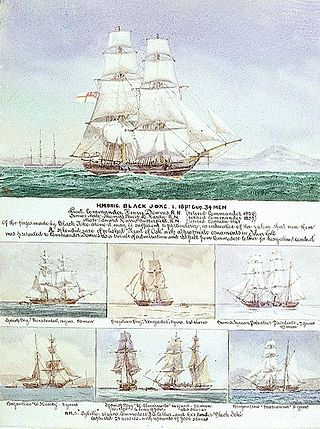Sierra Leone first became inhabited by indigenous African peoples at least 2,500 years ago. The Limba were the first tribe known to inhabit Sierra Leone. The dense tropical rainforest partially isolated the region from other West African cultures, and it became a refuge for peoples escaping violence and jihads. Sierra Leone was named by Portuguese explorer Pedro de Sintra, who mapped the region in 1462. The Freetown estuary provided a good natural harbour for ships to shelter and replenish drinking water, and gained more international attention as coastal and trans-Atlantic trade supplanted trans-Saharan trade.

United States v. Schooner Amistad, 40 U.S. 518 (1841), was a United States Supreme Court case resulting from the rebellion of Africans on board the Spanish schooner La Amistad in 1839. It was an unusual freedom suit that involved international diplomacy as well as United States law. The historian Samuel Eliot Morison described it in 1969 as the most important court case involving slavery before being eclipsed by that of Dred Scott v. Sandford in 1857.

The Blockade of Africa began in 1808 after the United Kingdom outlawed the Atlantic slave trade, making it illegal for British ships to transport slaves. The Royal Navy immediately established a presence off Africa to enforce the ban, called the West Africa Squadron. Although the ban initially applied only to British ships, Britain negotiated treaties with other countries to give the Royal Navy the right to intercept and search their ships for slaves.

Bunce Island is an island in the Sierra Leone River. It is situated in Freetown Harbour, the estuary of the Rokel River and Port Loko Creek, about 20 miles upriver from Sierra Leone's capital city Freetown. The island measures about 1,650 feet by 350 feet and houses a castle that was built by the Royal Africa Company in c.1670. Tens of thousands of Africans were shipped from here to the North American colonies of South Carolina and Georgia to be forced into slavery, and are the ancestors of many African Americans of the United States.

Sherbro Island is in the Atlantic Ocean, and is included within Bonthe District, Southern Province, Sierra Leone. The island is separated from the African mainland by the Sherbro River in the north and Sherbro Strait in the east. It is 32 miles (51 km) long and up to 15 miles (24 km) wide, covering an area of approximately 230 square miles (600 km2). The western extremity is Cape St. Ann. Bonthe, on the eastern end, is the chief port and commercial centre.

Îles de Los are an island group lying off Conakry in Guinea, on the west coast of Africa. Their name is derived from the Portuguese: Ilhas dos Ídolos, "Islands of the Idols". They are located about two kilometres off the headland limiting the southern side of Sangareya Bay.

The West Africa Squadron, also known as the Preventative Squadron, was a squadron of the British Royal Navy whose goal was to suppress the Atlantic slave trade by patrolling the coast of West Africa. Formed in 1808 after the British Parliament passed the Slave Trade Act 1807 and based out of Portsmouth, England, it remained an independent command until 1856 and then again from 1866 to 1867.
Michael Linning Melville was a Scots Barrister, Judge and Lieutenant Governor and Chief Justice of Sierra Leone. He was commissioned by King William IV of the United Kingdom to suppress the slave trade by force off the West Coast of Africa.
The liberated Africans of Sierra Leone, also known as recaptives, were Africans who had been illegally enslaved onboard slave ships and rescued by anti-slavery patrols from the West Africa Squadron of the Royal Navy. After the British Parliament passed the Slave Trade Act 1807, which abolished Britain's involvement in the slave trade, the Admiralty established the West Africa Squadron to suppress the trade in cooperation with other Western powers. All illegally enslaved Africans liberated by the Royal Navy were taken to Freetown, where Admiralty courts legally confirmed their free status. Afterwards, they were consigned to a variety of unfree labor apprenticeships at the hands of the Nova Scotian Settlers and Jamaican Maroons in Sierra Leone. During the 19th century, it has been estimated by historians that roughly 80,000 illegally enslaved Africans were liberated by the Royal Navy.

Cape Mesurado, also called Cape Montserrado, is a headland on the coast of Liberia near the capital Monrovia and the mouth of the Saint Paul River. It was named Cape Mesurado by Portuguese sailors in the 1560s. It is the promontory on which African-American settlers established the city now called Monrovia on 25 April 1822.
Sierra Leone assumed its present large geographical size only in 1896. Prior to that, it was only a small colony encompassing roughly the 30-km-long peninsula on which Freetown is located. Initially, the British and Creoles of the Freetown colony had only a very limited involvement in the affairs of the African kingdoms around them; such as it was, it consisted mostly of trading and missionary activity. Over the course of the 19th century this involvement gradually increased. The colonial government was, in particular, interested in fostering trade as this provided it with its main source of revenue, in the form of customs duties and other taxes. This inevitably drew it into engagement with the African kingdoms, mainly by making treaties with the kingdoms or sending military expeditions against them.
The Treaty between the United States and Great Britain for the Suppression of the Slave Trade, also known as the Lyons-Seward Treaty, was a treaty between the United States and Great Britain in an aggressive measure to end the Atlantic slave trade. It was negotiated by U.S. Secretary of State William H. Seward and British Ambassador to the U.S. Richard Lyons, 1st Viscount Lyons. The treaty was concluded in Washington, on April 7, 1862, and was unanimously ratified by the U.S. Senate on April 25, 1862. Ratifications were exchanged in London, on May 25, 1862.

HMS Tigress was the American merchantman Numa and then French letter of marque Pierre Cézar that the Royal Navy acquired by capture and put into service as the gunbrig Tigress. She spent some time on the West African coast in the suppression of the Triangular slave trade. The Admiralty later renamed her as Algerine. She was broken up in 1818.
HMS Brazen was a 28-gun Royal Navy Bittern-class ship sloop, launched in 1808.

The African Institution was founded in 1807 after British abolitionists succeeded in ending the slave trade based in the United Kingdom. The Institution was formed to succeed where the former Sierra Leone Company had failed—to create a viable, civilised refuge for freed slaves in Sierra Leone, in West Africa. It was led by James Stephen and William Wilberforce. From 1823, its work was mostly taken over by the Society for the Mitigation and Gradual Abolition of Slavery Throughout the British Dominions, and it ceased to exist sometime between 1826 and 1828.
HMS Nimble was a Royal Navy 5-gun schooner-of-war. She was employed in anti-slave trade patrol from 1826 until 1834, when she was wrecked on a reef with the loss of 70 Africans who had been rescued from a slave ship.
Donna Marianna was a vessel that left Liverpool in 1809. On 22 May 1810 HMS Crocodile seized Donna Marianna for breach of the Act for the abolition of the slave trade. The Vice admiralty court at Freetown, Sierra Leone, condemned Donna Mariana and her owners appealed the decision. The result of the appeal was a finding against the owners in a case that became an important milestone in the suppression of the slave trade.
Dart was a ship launched in South America under a different name. She was taken in prize circa 1806. Once under British ownership she performed one voyage as a whaler in the southern whale fishery. She then traded as a merchantman before in 1810 receiving a letter of marque. As a privateer she did something quite unusual: she made a voyage to Africa where she captured five slave ships. After this Dart returned to normal trading, this time with South America. In 1813 as she was returning to London from Buenos Aires she stopped at Pernambuco, where she was condemned as unseaworthy.
The Anglo-Dutch Slave Trade Treaty was a treaty signed between the United Kingdom and the Kingdom of the Netherlands signed on 4 May 1818, aimed at preventing slave trade carried out through Dutch vessels. The treaty allowed both parties to search vessels of the other for on-board slaves. Among other things, the treaty established two Mixed Commission Courts, one with a seat in Freetown, Sierra Leone and another in Paramaribo, Suriname, which had the power to sentence slavers.

HMS Esk was a Cyrus-class ship-sloop launched at Ipswich in 1813. During the War of 1812 she captured one United States privateer, and fought an inconclusive action with another. Between 1825 and 1827 Esk was part of the West Africa Squadron, engaged in suppressing the trans-Atlantic slave trade, during which period she captured a number of slave ships. A prize she had taken also engaged in a notable single ship action. The Royal Navy sold Esk in 1829. Green, Wigram, and Green purchased her and between 1829 and 1845 she made four voyages in the British southern whale fishery as the whaler Matilda.









